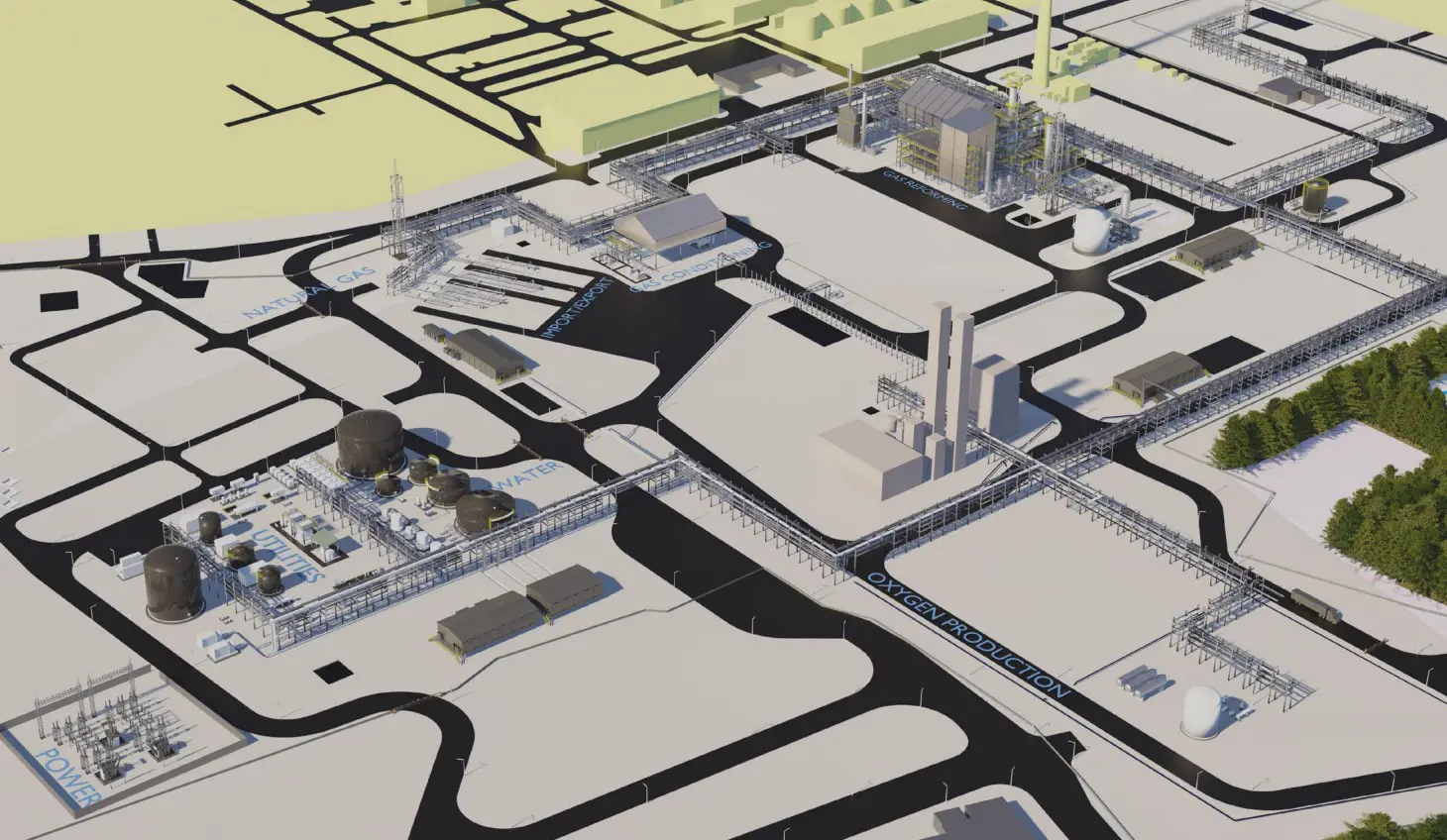


EET Hydrogen has received approval to begin construction on the first large-scale, low-carbon hydrogen production plant (HPP1) in the United Kingdom. Ultimately consisting of two plants (HPP1 and HPP2), the hydrogen hub will be located at the Stanlow Manufacturing Complex in Ellesmere Port, Cheshire, enabling local industrial and power generation businesses to use low-carbon energy. The hydrogen will be used locally by the Essar refinery and other major manufacturers in the region, including Tata Chemicals, Encirc, and Pilkington, to create low-carbon refining operations and glass and chemicals manufacturing sites. According to EET Hydrogen, this will help to reduce the North West’s carbon emissions by 2.5 MTPA.
EET Hydrogen will develop the hydrogen hub in phases, with the first plant (HPP1) at 350-MW capacity, the second (HPP2) at 1000-MW capacity, and an overall target capacity of 4000 MW+ by 2030. HPP1 will use Johnson Matthey’s LCH hydrogen production technology. According to Johnson Matthey, LCH offers very high overall efficiency by coupling a gas heated reformer (GHR) with an autothermal reformer (ATR). The main differences between the LCH and typical steam methane reforming (SMR) are that the energy to drive the reaction is provided by introducing oxygen to the ATR as opposed to burning natural gas in air in an SMR, and that carbon dioxide (CO2) can be removed from the product gas (syngas) at pressure — allowing for smaller vessels and greater capture rates.
Purified natural gas is pre-heated and reformed in the GHR before entering the ATR. In the GHR, 30% of the total hydrocarbon is reformed by reaction with steam to form syngas. In the second stage, the ATR, oxygen is added and combusts some of the partially reformed gas to raise the process gas temperature. The resultant gas then passes through a bed of reforming catalyst inside the same vessel for further reforming. Since the reaction is limited by equilibrium, operation at high temperature and steam flows minimizes the methane content of the product gas which in turn minimizes overall CO2 emissions. The hot gas exiting the ATR passes back to the GHR providing the heat necessary to drive the reforming reaction in the GHR tubeside. The syngas, following reforming, is passed through the Isothermal Shift Converter, where the residual carbon monoxide reacts with water to produce additional product hydrogen. This reaction is exothermic, so is used to generate additional steam for the process.
Construction is expected to start on HPP1 in 2024 with hydrogen produced at the site by 2027.
Plant 2
In September 2023, KBR was awarded the front-end engineering design (FEED) contract by EET Hydrogen for HPP2. Under the terms of the agreements, KBR will provide technology licensing, proprietary engineering design and equipment, catalyst, and FEED for up to 1000-MW plant capacity to be located at the Stanlow Manufacturing Complex.
“We are excited to support EET Hydrogen on this significant decarbonization project. KBR will apply its proprietary hydrogen knowledge and technology to help deliver the largest blue hydrogen energy transition project in the UK,” said Jay Ibrahim, president of KBR Sustainable Technology Solutions. “This strategic win attests to our commitment toward helping our clients with both their ESG and business objectives.”


HyNet Northwest
The hydrogen hub is critical to meet the UK’s hydrogen and industrial decarbonization targets and is a key pillar of HyNet Northwest — an industrial decarbonization cluster managed by Progressive Energy. HyNet Northwest will produce, store, and distribute hydrogen as well as capture and store carbon from industry in the Northwest of England and North Wales. It will use state-of-the art technology to build new infrastructure, while also upgrading and reusing existing infrastructure, which is currently involved in fossil fuel production.
“We are delighted that HyNet’s low-carbon hydrogen production plant has been given the green flag to begin construction,” said HyNet Project Director David Parkin. “The plant will provide locally produced hydrogen to industry across the region, enabling them to switch their fuel to a low-carbon alternative.”
Hydrogen will be manufactured at the Stanlow Manufacturing Complex and transported by underground pipelines. Cadent Gas Ltd. is developing 77 miles (125 km) of new pipeline, the UK’s first 100% hydrogen pipeline network at scale.
A complex of hydrogen storage salt caverns will be created in the Cheshire salt basin and connected to the hydrogen distribution network. The complex will be able to store around 1.3 TWh of hydrogen, to enable fluctuations in demand to be managed cost effectively, without sizing the production hub to meet peak regional demand.
Hydrogen production will be linked to a carbon capture and storage (CCS) transport and storage system, designed specifically to sequester CO2 produced by hydrogen production and other industrial sources into long-term geological storage in the depleted Liverpool Bay gas fields.
HyNet will deliver 35% of the UK’s 1-GW hydrogen target by 2025, 75% of the entire UK target of 5 GW of hydrogen by 2030 and CO2 CCS capacity for 10 MTPA by 2030, equal to the entire UK 2030 target.
“This is the largest low-carbon hydrogen project in the UK and one of the most advanced in the world. It is a vital piece of the Northwest’s journey to net zero, underpinning HyNet and providing the opportunity for manufacturers in the region to decarbonize their processes and support UK jobs,” said Richard Holden, HPP1 project manager at EET Hydrogen. “We have worked closely with regional stakeholders and are delighted to obtain this important approval for the project as we move from ambition to action.”